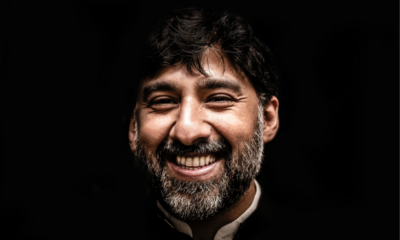Life
5 Steps to Living Your Personal Legend

Derek Sivers said, “Don’t be on your deathbed someday having squandered your one chance at life, full of regret because you pursued little distractions instead of big dreams.”
Those big dreams are what Paulo Coelho called “Personal Legends” in The Alchemist. It’s comparable to your life purpose.
When you live your Personal Legend, you tend to experience synchronicities, live life in flow and are well on your way to self-actualization. That’s the path to soul-level fulfillment.
Deep down, every human longs for a sense of purpose and meaning in life. The problem is that we often seek those in the wrong places. Fulfillment doesn’t come from grandiose accomplishments, prestige, or doing what others expect of us; it comes from living our Personal Legends.
When we ignore the inner call to pursue that particular path, we go through life with a nagging feeling that something is missing. We also risk ending up with regrets in the future. However, that’s totally avoidable; there’s still time to pursue your Personal Legend.
Here’s how you can do it.
1. Follow the Breadcrumbs
To live your Personal Legend, you must follow your heart—your heart-centered dreams and desires. Those are the things that make you feel alive, inspired, excited, and energized and that spark curiosity within you.
Too many people discard their dreams because they’ve convinced themselves that they aren’t “reasonable.” But your heart-centered desires aren’t just childish fantasies; they are breadcrumbs guiding you to your most authentic and fulfilling life.
Plus, as Paulo Coelho wrote, “You will never be able to escape from your heart, so it’s better to listen to what it has to say.”
2. Don’t Fall for the Ego’s “Wants” or the “Shoulds” of Society
One of the main difficulties in living our Personal Legends is differentiating our heart’s desires from the “wants” of our egos or the “shoulds” of conditioning.
The ego’s “wants” are rooted in fear, need, and feelings of lack. For example, when I was a teenager, I dreamed of becoming a famous actress and living in Hollywood. I was doing theater and enjoyed acting, but wanting to be famous wasn’t a heart-centered desire; it was just my ego. My ego craved recognition and praise. It wanted to feel important.
As for the desires that come from conditioning, those are the things our education and society taught us we “should” do. For example, I went to university because I was told growing up that intelligent people get college degrees (which, of course, is untrue). I wasn’t particularly excited about going to university, and it ended up being a waste of time and money.
To differentiate your heart-centered dreams and desires from those of your ego or conditioning, write down what you want. Next, for each thing, write down why you want it. Ask yourself “why” five times to go deeper. Then, look at the reasons you want each item on your list. Is it to receive praise, obtain a certain social status, or feel superior to others? That’s the ego. Is it because you were told it’s what you should do? That’s conditioning. Is it because it makes you feel alive, vibrant, and inspired? That’s your heart.
3. Commit to Pursuing Your Personal Legend
Pursuing our Personal Legends requires commitment, even devotion. If we keep putting our dreams on the back burner, we’re not committed and probably won’t achieve them.
To commit to your dreams, you can start by writing them down and reading them daily. You can also create a vision board and even visualize them. Most importantly, make room for them in your life. If you feel curious about salsa dancing, take a class. If you love animals, why not volunteer at a shelter once a week? If you feel drawn to deserts, plan a trip to visit one.
My mom has always felt drawn to deserts. She asked for a travel book with beautiful images of deserts around the world for Christmas, collects silk scarfs, and has photos of Northern Africa all over her office’s wall. But she never went on a trip to see one with her own eyes. “It’s too complicated,” she’d explain. “It’s too far.” A portion of her Personal Legend will die within her, and it’s a bit sad.
4. Rely On Your Inner Knowing
Perhaps you’ve heard the saying, “The quickest way to kill a dream is to tell a small-minded person about it.” Until you’re entirely confident in your ability to make your dream come true, it’s best to keep it to yourself or, at least, only share it with those you know will support you.
Especially don’t share your dream just to seek validation. When you seek validation, you aren’t entirely confident in yourself, and it’s in those moments that your vision is the most at risk of being crushed by “small-minded people” or people who don’t understand what you’re trying to accomplish.
Plus, no one knows what your Personal Legend is better than you, so their opinion should hold very little value. Learn to trust your own inner knowing and not rely on external validation.
5. Feel the Fear and Go for It Anyway
Paulo Coelho wrote in The Alchemist, “Don’t give in to your fears. If you do, you won’t be able to follow your heart. […] There is only one thing that makes a dream impossible to achieve: the fear of failure.”
When you set out to live your Personal Legend, you inevitably encounter resistance—fears, doubts, and insecurities—that can sabotage your progress and success. That’s because living your Personal Legend requires you to step into the unknown, which your ego sees as risky. Your ego’s job is to keep you safe, meaning within the confines of what’s known and habitual. You need to be stronger than your ego. Feel the fear, take a deep breath, smile, and go for it.
Here’s an effective way to remove the resistance caused by fear: visualize yourself having achieved your goal. Because your subconscious mind doesn’t differentiate what’s real from what you vividly imagine, you’ll trick it into believing that you’ve already done it. And, since you’re still alive, your ego will also think that it’s safe for you to pursue that dream, and it won’t cause as much resistance.
Your heart-centered dreams aren’t childish fantasies; they are guiding you to living your Personal Legend, your life purpose. Dare to pursue them! You’ll thank yourself for it when you get to the end of your life.
Did You Know
How Skilled Migrants Are Building Successful Careers After Moving Countries
Behind every successful skilled migrant career is a mix of resilience, strategy, and navigating systems built for locals.

Moving to a new country for work is exciting, but it can also be unnerving. Skilled migrants leave behind familiar systems, networks, and support to pursue better job opportunities and a better future for their families. (more…)
Life
10 Research-Backed Steps to Create Real Change This New Year
This New Year could finally be the one where you break old patterns and create real, lasting change.

Every New Year, we make plans and set goals, but often repeat old patterns. (more…)
Life
9 Harsh Truths Every Young Man Must Face to Succeed in the Modern World
Before chasing success, every young man needs to face these 9 brutal realities shaping masculinity in the modern world.

Many young men today quietly battle depression, loneliness, and a sense of confusion about who they’re meant to be.
Some blame the lack of deep friendships or romantic relationships. Others feel lost in a digital world that often labels traditional masculinity as “toxic.”
But the truth is this: becoming a man in the modern age takes more than just surviving. It takes resilience, direction, and a willingness to grow even when no one’s watching.
Success doesn’t arrive by accident or luck. It’s built on discipline, sacrifice, and consistency.
Here are 9 harsh truths every young man should know if he wants to thrive, not just survive, in the digital age.
1. Never Use Your Illness as an Excuse
As Dr. Jordan B. Peterson often says, successful people don’t complain; they act.
Your illness, hardship, or struggle shouldn’t define your limits; it should define your motivation. Rest when you must, but always get back up and keep building your dreams. Motivation doesn’t appear magically. It comes after you take action.
Here are five key lessons I’ve learned from Dr. Peterson:
-
Learn to write clearly; clarity of thought makes you dangerous.
-
Read quality literature in your free time.
-
Nurture a strong relationship with your family.
-
Share your ideas publicly; your voice matters.
-
Become a “monster”, powerful, but disciplined enough to control it.
The best leaders and thinkers are grounded. They welcome criticism, adapt quickly, and keep moving forward no matter what.
2. You Can’t Please Everyone And That’s Okay
You don’t need a crowd of people to feel fulfilled. You need a few friends who genuinely accept you for who you are.
If your circle doesn’t bring out your best, it’s okay to walk away. Solitude can be a powerful teacher. It gives you space to understand what you truly want from life. Remember, successful men aren’t people-pleasers; they’re purpose-driven.
3. You Can Control the Process, Not the Outcome
Especially in creative work, writing, business, or content creation, you control effort, not results.
You might publish two articles a day, but you can’t dictate which one will go viral. Focus on mastery, not metrics. Many great writers toiled for years in obscurity before anyone noticed them. Rejection, criticism, and indifference are all part of the path.
The best creators focus on storytelling, not applause.
4. Rejection Is Never Personal
Rejection doesn’t mean you’re unworthy. It simply means your offer, idea, or timing didn’t align.
Every successful person has faced rejection repeatedly. What separates them is persistence and perspective. They see rejection as feedback, not failure. The faster you learn that truth, the faster you’ll grow.
5. Women Value Comfort and Security
Understanding women requires maturity and empathy.
Through books, lectures, and personal growth, I’ve learned that most women desire a man who is grounded, intelligent, confident, emotionally stable, and consistent. Some want humor, others intellect, but nearly all want to feel safe and supported.
Instead of chasing attention, work on self-improvement. Build competence and confidence, and the rest will follow naturally.
6. There’s No Such Thing as Failure, Only Lessons
A powerful lesson from Neuro-Linguistic Programming: failure only exists when you stop trying.
Every mistake brings data. Every setback builds wisdom. The most successful men aren’t fearless. They’ve simply learned to act despite fear.
Be proud of your scars. They’re proof you were brave enough to try.
7. Public Speaking Is an Art Form
Public speaking is one of the most valuable and underrated skills a man can master.
It’s not about perfection; it’s about connection. The best speakers tell stories, inspire confidence, and make people feel seen. They research deeply, speak honestly, and practice relentlessly.
If you can speak well, you can lead, sell, teach, and inspire. Start small, practice at work, in class, or even in front of a mirror, and watch your confidence skyrocket.
8. Teaching Is Leadership in Disguise
Great teachers are not just knowledgeable. They’re brave, compassionate, and disciplined.
Teaching forces you to articulate what you know, and in doing so, you master it at a deeper level. Whether you’re mentoring a peer, leading a team, or sharing insights online, teaching refines your purpose.
Lifelong learners become lifelong leaders.
9. Study Human Nature to Achieve Your Dreams
One of the toughest lessons to accept: most people are self-interested.
That’s not cynicism, it’s human nature. Understanding this helps you navigate relationships, business, and communication more effectively.
Everyone has a darker side, but successful people learn to channel theirs productively into discipline, creativity, and drive.
Psychology isn’t just theory; it’s a toolkit. Learn how people think, act, and decide, and you’ll know how to lead them, influence them, and even understand yourself better.
Final Thoughts
The digital age offers endless opportunities, but only to those who are willing to take responsibility, confront discomfort, and keep improving.
Becoming a man today means embracing the hard truths most avoid.
Because at the end of the day, success isn’t about luck. It’s about who you become when life tests you the most.
Change Your Mindset
The Four Types of Happiness: Which One Are You Living In?
Most people chase success only to find emptiness, this model reveals why true happiness lies somewhere else.

In a world driven by rapid technological growth and constant competition, many people unknowingly trade joy for achievement. (more…)
-

 Did You Know4 weeks ago
Did You Know4 weeks agoThe Success Patterns You Inherited (And Didn’t Notice)
-

 Entrepreneurs3 weeks ago
Entrepreneurs3 weeks agoThe Essential Skills Every Entrepreneur Needs In 2026
-

 Business4 weeks ago
Business4 weeks agoThe Hidden Money Pit in Your Operations (and How to Use It)
-

 Change Your Mindset3 weeks ago
Change Your Mindset3 weeks agoHow to Turn Your Mind Into Your Greatest Asset (Instead of Your Enemy)
-

 Change Your Mindset3 weeks ago
Change Your Mindset3 weeks agoThe Silent Skill That Makes People Respect You Instantly
-

 Life2 weeks ago
Life2 weeks ago10 Research-Backed Steps to Create Real Change This New Year
-

 Tech2 weeks ago
Tech2 weeks agoWhat’s in a Name? How to Get Your Domain Right
-

 Did You Know1 week ago
Did You Know1 week agoHow Skilled Migrants Are Building Successful Careers After Moving Countries























